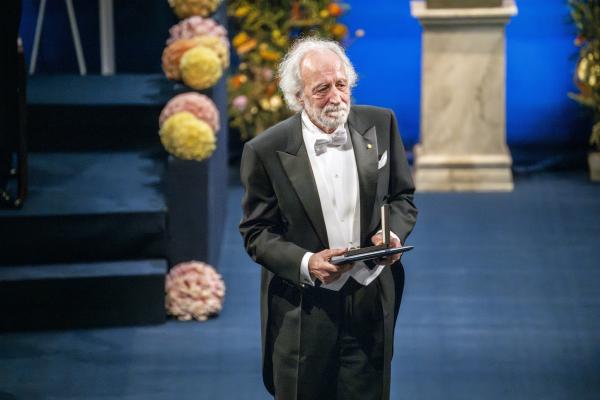Agostini is awarded Nobel Prize, while Ohio State cheers

(Article written by Jeff Grabmeier for Ohio State News)
(Photo credit for first photo of slideshow: Fanny Staveby Widinghoff)
Photo credits for thumbnail photo, and second, third, and sixth photos of slideshow: © Nobel Prize Outreach. Photo: Nanaka Adachi
Emeritus professor of physics receives medal from King of Sweden
It may have been some 4,200 miles away from the ceremony in Stockholm, Sweden, but the applause couldn’t have sounded any sweeter than it did at The Ohio State University Sunday when Pierre Agostini received his Nobel Prize in Physics.
Students, researchers and friends of Ohio State’s Department of Physics gathered in a seminar room at the Physics Research Building early on the chilly morning to watch the livestream of one of their own receiving the prize.
They watched the large screen as Agostini, professor emeritus of physics, walked across the stage to receive the medal from the King of Sweden. The room burst into applause. (See a recording of the livestream at the Nobel Prize website.)
No one was more excited than those who work directly with the new Nobel Laureate at the Agostini-Dimauro Atomic Physics Research Group.
“Pierre is just such a deserving person,” said Dan Tuthill, a graduate student in physics at the lab.
“It is a great triumph for a very long line of work.”
Members of his lab were especially excited because the award was so unexpected, even if it was richly deserved.
“Of course, we knew Pierre had done a lot of great work. But it is just so hard to imagine that someone we worked with would get the Nobel Prize,” said Yaguo Tang, a postdoctoral researcher in the lab.
Those who work with Agostini say he is brilliant, but also thoughtful and approachable.
“Pierre is just a wonderful person to work with. Just extremely knowledgeable,” Tuthill said. “You’ll give a presentation and three hours later he will come find you and say, ‘I’ve been thinking about this -- let’s talk about it.’”
Tahereh Alavai, a postdoctoral researcher in the lab, agrees. “I’m glad to have had this opportunity to work with him.”
The ceremony was the culmination of several weeks of events celebrating Agostini.
On Nov. 29, the Department of Physics held a colloquium celebrating Ohio State’s Nobel Prize winner, with Agostini in attendance via video.
Agostini’s lab partner at Ohio State, Professor of Physics Lou DiMauro, told the overflow audience that spilled out of the Robert Smith Seminar Room about the work that earned him the Nobel.
The work of Agostini and his co-winners of this year’s physics prize (Ferenc Krausz from the Max Planck Institute of Quantum Optics and Anne L’Huillier from Lund University in Sweden) allowed scientists to capture the movement of electrons.
The researchers generated attosecond pulses of light to study electrons. How long is an attosecond? DiMauro explained that there are as many attoseconds in a second as there are seconds in the age of the universe.
“And that’s what the achievement is. It is the shortest pulses humans know how to make,” DiMauro said at the colloquium.
Ever the scientist, Agostini was already excited about what is happening next in the field of ultra-fast physics.
“Talking about attoseconds is almost obsolete now … There are already a number of publications talking about zeptoseconds,” he told the colloquium audience.
Agostini expanded on this topic at his official Nobel Prize lecture (watch the YouTube recording), wondering aloud whether it is possible to divide time into infinity. “From a physics standpoint, I would say that’s doubtful,” he said.
What’s not doubtful is the impact of Agostini’s Nobel, for him and for Ohio State.
“Being awarded the Nobel Prize is the pinnacle for a researcher’s career,” said Peter Mohler, Ohio State acting president.
“Ohio State is so proud of Prof. Agostini and his achievements, and we look forward to seeing his lab and the Department of Physics continue to expand on his groundbreaking work.”
Sherry Chan, a member of the Dean’s Advisory Committee for the College of Arts and Sciences, talked about the Nobel Prize impact after attending the livestream of the ceremony.
“It is a culmination of a lot of work here,” Chan said. “Ohio State always had the knowledge and the research, and now we are recognized on an international stage.”
As for Agostini, he seemed a bit overwhelmed with all the attention he was getting at the physics colloquium, but also thankful for the support of his colleagues at Ohio State.
“I’m very grateful to the physics department to have given me this position almost 20 years ago now,” he said.
Read the original article here.
You can watch the recordings of the Nobel Ceremony, Concert, and Lectures on the Nobel Prize website.
For further reading, check out this Eleven Warriors article.
Learn more about the Nobel Prize in physics.






